



















|
 |
|
 |

As one of the Diadochi, the Ptolemaioi armies fight in the Macedonian tradition, with pike phalanxes as line infantry to tie down the enemy formations and cavalry to flank them. The Ptolemaioi also have other non-Hellenic troops to augment their Hellenic units, like Galatian & Ethiopian heavy infantry.
Pantodapoi (Hellenic Native Spearmen)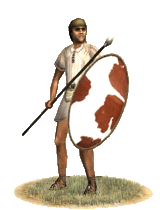 The most basic and numerous of the infantry units used by the non-European Successor States were the Pantodapoi infantry. These men were called from a variety of nationalities and were usually settled in certain areas for garrison duties and the like. There were Jews, Syrians, Cilicians, Persians, Assyrians, Native Egyptians, and many other peoples counted among their number. They are not particularly reliable soldiers, but they are certainly better than their eastern counterparts. They can give a good account of themselves in battle if deployed properly. They wear no armor, and have only a light shield for protection, so most other infantry will slaughter them in droves. They can fend off light cavalry for a time, if need be. The most basic and numerous of the infantry units used by the non-European Successor States were the Pantodapoi infantry. These men were called from a variety of nationalities and were usually settled in certain areas for garrison duties and the like. There were Jews, Syrians, Cilicians, Persians, Assyrians, Native Egyptians, and many other peoples counted among their number. They are not particularly reliable soldiers, but they are certainly better than their eastern counterparts. They can give a good account of themselves in battle if deployed properly. They wear no armor, and have only a light shield for protection, so most other infantry will slaughter them in droves. They can fend off light cavalry for a time, if need be.
Historically, the Pantodapoi were a group of various nationalities that were used as a militia levy and defensive group for towns and villages prone to raiding. While the name is conceptual (meaning, from everywhere), they were a standard fighting force of the day. They were trained rudimentarily, but had enough training to be counted as superior to many militia levies. They had some experience fighting off nomadic raiders, so they can be useful against light troops and some light cavalry.
Akontistai (Hellenic Skirmishers)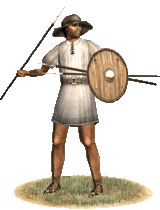 Those unlucky enough to be extremely poor freedmen were pressed into service as psiloi, missile units, and the lowest class of Hellene infantry. The psiloi were divided into three parts: javelineers, slingers, and archers. The javelin-armed psiloi, the akonistai, were ragged peasants armed with javelins and small knives. Their function was simply to throw their missiles and then run as fast as possible to safety behind the hoplitai lines. They were used for skirmishing and to provide a demoralizing hail of missile fire during the grinding battle between the two phalanxes. Never use akonistai in melee except as diversionary fodder or as a flanking force; roles in which they don't excel, but might actually be better than nothing. They have their uses, as their javelins are still sharp and deadly, but they were often used only as light skirmishers or as a last resort in Hellenic armies for obvious reasons. Those unlucky enough to be extremely poor freedmen were pressed into service as psiloi, missile units, and the lowest class of Hellene infantry. The psiloi were divided into three parts: javelineers, slingers, and archers. The javelin-armed psiloi, the akonistai, were ragged peasants armed with javelins and small knives. Their function was simply to throw their missiles and then run as fast as possible to safety behind the hoplitai lines. They were used for skirmishing and to provide a demoralizing hail of missile fire during the grinding battle between the two phalanxes. Never use akonistai in melee except as diversionary fodder or as a flanking force; roles in which they don't excel, but might actually be better than nothing. They have their uses, as their javelins are still sharp and deadly, but they were often used only as light skirmishers or as a last resort in Hellenic armies for obvious reasons.
Historically, akontistai did not play a particularly large role on the battlefield, and weren't normally a particularly decisive force. They were used mainly for their ability to induce an enemy to attack prematurely. They are little more than an annoyance on the open field, but can be deadly if positioned in places where their javelins can be used for maximum effect: on high terrain, on an enemy unit's flank, or atop a city wall.
Sphendonetai (Hellenic slingers)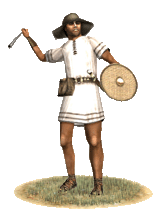 Sphendonetai are the second branch of the psiloi, and are only marginally more useful than their compatriots with javelins. Their sphendonai (slings) can prove deadly weapons, being able to crush bones and armor, and shatter shields from a distance, but they are mainly used to harass and annoy enemy soldiers to force a premature or rash action. Since a sphendone is an easily constructed weapon, and ammo is readily available in Hellas' rocky terrain, Sphendonetai are mostly poor peasants and shepherds that use this weapon to provide a meager amount of protein in their already poor diet or use their weapons to keep predators away from their flocks. Sphendonetai are the second branch of the psiloi, and are only marginally more useful than their compatriots with javelins. Their sphendonai (slings) can prove deadly weapons, being able to crush bones and armor, and shatter shields from a distance, but they are mainly used to harass and annoy enemy soldiers to force a premature or rash action. Since a sphendone is an easily constructed weapon, and ammo is readily available in Hellas' rocky terrain, Sphendonetai are mostly poor peasants and shepherds that use this weapon to provide a meager amount of protein in their already poor diet or use their weapons to keep predators away from their flocks.
Historically, sphendonetai had their uses, they were often used to harass and provoke the enemy forces by causing some casualties and some damage to the enemy's armament, particularly the shields, which were easily dented or cracked by a well slung glande (sling projectile). Alexandros employed his sphendonetai at the battle of Gaugamela to harass the Persian heavy cavalry until they decided to give fight, and then promptly cut them off from the rest of the Persian army, allowing the Hetairoi to cut them to shreds.
Toxotai (Hellenic Archers)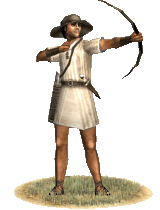 Toxotai are the third branch of the psiloi, the archers of Hellene and Makedonian armies. They are generally from the upper end of the poor and recruited from mountainous regions where the use of the bow is an essential skill to keep one's flock of sheep safe from roving predators. Toxotai are well trained in a manner of speaking, that being that they are using their weapon of choice (often of necessity) from birth. They are decent archers, but are nowhere near as professional as the archers from the east and south. They mostly use the short bow, which means that they are often outgunned by their counterparts from other lands. This reflects their secondary role in a Hellenic army. As most missile units, they will be cut to ribbons in melee, so they should be well protected from enemy ranks. Toxotai are the third branch of the psiloi, the archers of Hellene and Makedonian armies. They are generally from the upper end of the poor and recruited from mountainous regions where the use of the bow is an essential skill to keep one's flock of sheep safe from roving predators. Toxotai are well trained in a manner of speaking, that being that they are using their weapon of choice (often of necessity) from birth. They are decent archers, but are nowhere near as professional as the archers from the east and south. They mostly use the short bow, which means that they are often outgunned by their counterparts from other lands. This reflects their secondary role in a Hellenic army. As most missile units, they will be cut to ribbons in melee, so they should be well protected from enemy ranks.
Historically, the Hellenes did not use archers in any significant fashion. They did not have the composite bows of their neighbors, and their lands were not particularly suited to the cattle and horse farming that supplied the raw material for these bows. Therefore, archers fulfilled the same role as other psiloi: that of long range harassment. The Hellenes and Makedonians had no real tradition of archers and could not recruit any but these shepherds to do this work for them, since they lacked any access to the archers of the east. Most Hellene states relied on Skythian and most importantly Kretan archers to do this for them.
Hippakontistai (Hellenic Skirmisher Cavalry)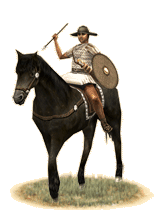 Hippos Akontistes (literally "javelin horsemen") are the standard among Hellene light cavalry. They are lightly armored, often wearing nothing but padded cloth for protection. The key to their method of warfare is speed, and they are armed accordingly. They ride small, but swift horses and harass enemy infantry and heavy cavalry with javelins. This is their primary use, because their light armor is really a detriment when they are engaged in any kind of melee combat. Their swords and shields are simply no counter to lances or heavier cavalry swords. Hippos Akontistes (literally "javelin horsemen") are the standard among Hellene light cavalry. They are lightly armored, often wearing nothing but padded cloth for protection. The key to their method of warfare is speed, and they are armed accordingly. They ride small, but swift horses and harass enemy infantry and heavy cavalry with javelins. This is their primary use, because their light armor is really a detriment when they are engaged in any kind of melee combat. Their swords and shields are simply no counter to lances or heavier cavalry swords.
Historically, Hellas did not have a great tradition of light cavalry warfare, or indeed of any cavalry warfare. Hippakontistai were much like the Equites of Rome, the spoiled children of the richest families that could afford horses. They were usually not used in any front line capacity other than skirmishing and pursuit, and their equipment reflects this. Makedonian cavalry of the same type operates in a similar fashion, but generally comes from the poorest noble families, those who can afford horses but not the heavy armor required for the heavy cavalry.
Machimoi (Native Egyptian Infantry)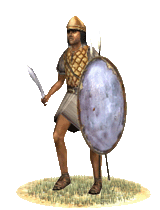 The Machimoi were an important part of Aigyptian society long before the arrival of the Hellenes and the new Pharoanic dynasty of the Ptolemaioi. Aigyptian society consisted, aside from the royal family, primarily of the priests, the warriors--or Machimoi, and the farmers. These men are drawn from the largest section of the Machimoi, and armed with several javelins, a sword, and a shield, and armored with a light cuirass and mass-produced helmet. They are competent in basic wartime and garrison duties, but should not be expected to succeed in combat against well-trained units or in other daunting situations. They may once have been a warrior class, but for hundreds of years many of the Machimoi have spent most of their lives farming or trading, not fighting. The Machimoi were an important part of Aigyptian society long before the arrival of the Hellenes and the new Pharoanic dynasty of the Ptolemaioi. Aigyptian society consisted, aside from the royal family, primarily of the priests, the warriors--or Machimoi, and the farmers. These men are drawn from the largest section of the Machimoi, and armed with several javelins, a sword, and a shield, and armored with a light cuirass and mass-produced helmet. They are competent in basic wartime and garrison duties, but should not be expected to succeed in combat against well-trained units or in other daunting situations. They may once have been a warrior class, but for hundreds of years many of the Machimoi have spent most of their lives farming or trading, not fighting.
The Ptolemaioi eventually organized the Machimoi class into three distinct levels: the 5-aroura machimoi, the 7-aroura Machimoi, and the Machimoi epilektoi. The machimoi epilektoi formed the auxiliary phalanx at Raphia, and may not have existed until the reforms leading up to the Raphia campaign. The 5-aroura Machimoi served as light troops: Toxotai, Akontistai, and the like, and may have been part of the recruitment pool for the Phulakitai, the regional police. These are the 7-aroura Machimoi, who likely saw extensive use on a reserve basis in the Ptolemaic fleets, in various garrisons both in Aigyptos and overseas, and on both sides of the many civil wars which wracked the Ptolemaic state from the late third century on. While this population initially consisted almost exclusively of native Aigyptians, years of immigration and Hellenization have changed the makeup of the Machimoi to a considerable degree. While it still maintained a native Aigyptian character, the vast majority of Machimoi had first- or second-generation Hellenic, Asian, Galatian, or Thraikian ancestors.
Machimoi Phalangitai (Machimoi Native Phalanx)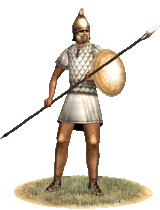 The Machimoi are Aigyptoi natives who have been conscripted to fight in the traditional Makcedonian fashion. They are armed with all the standard phalanx equipment including the sarissa, the Phrygian cap, and the small Illyrian shield. They wear quilted cloth armor due to the harsh Aigyptian climate. They are reputable enough fighters, but have a history of rebellion, so they are far more expensive than most troops of the same caliber. This has to be dealt with though, since the Ptolemaioi simply do not have the numbers of Hellenes to fill their armies with. Machimoi have decent morale and can be relied upon as capable troops. Their weaknesses are the same as any pike phalanx, in that they are immobile and prone to flank attacks and missile fire. If used accordingly, they will give good account of themselves. The Machimoi are Aigyptoi natives who have been conscripted to fight in the traditional Makcedonian fashion. They are armed with all the standard phalanx equipment including the sarissa, the Phrygian cap, and the small Illyrian shield. They wear quilted cloth armor due to the harsh Aigyptian climate. They are reputable enough fighters, but have a history of rebellion, so they are far more expensive than most troops of the same caliber. This has to be dealt with though, since the Ptolemaioi simply do not have the numbers of Hellenes to fill their armies with. Machimoi have decent morale and can be relied upon as capable troops. Their weaknesses are the same as any pike phalanx, in that they are immobile and prone to flank attacks and missile fire. If used accordingly, they will give good account of themselves.
Historically, the Machimoi were used with good effect at Raphia and other battles. Once they realized their own power, however, they soon began to revolt against their Hellene and Makedonian rulers. The Ptolemies looked for different racial groups to settle in Aigyptos to counter this disparity, and ended up importing large amounts of Ioudaioi and Galatai to fill the ranks. Still, the Machimoi were used as a necessity, and often gave good accounts of themselves in battle.
Iudaioi Taxeis (Jewish Spearmen)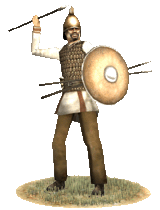 These Ioudaioi Taxeis have been recruited in the army for the purpose of providing reliable garrison troops, useful for policing borders and keeping the general population in line. They have been given somewhat outdated equipment consisting of a Phrygian helmet, a solid spear, javelins and a round shield. Though generally unimpressive, many of the soldiers supplement this equipment with armor purchased or manufactured on their own. This added body armor, combined with a good track record of loyalty and valor, make them a tough and reliable medium infantry force, capable of taking on much heavier opponents. This makes them excellent troops to fight off the occasional raids from desert peoples or hold off a more serious invasion until more professional reinforcements have arrived. These Ioudaioi Taxeis have been recruited in the army for the purpose of providing reliable garrison troops, useful for policing borders and keeping the general population in line. They have been given somewhat outdated equipment consisting of a Phrygian helmet, a solid spear, javelins and a round shield. Though generally unimpressive, many of the soldiers supplement this equipment with armor purchased or manufactured on their own. This added body armor, combined with a good track record of loyalty and valor, make them a tough and reliable medium infantry force, capable of taking on much heavier opponents. This makes them excellent troops to fight off the occasional raids from desert peoples or hold off a more serious invasion until more professional reinforcements have arrived.
The Ptolemaioi, who after the battle of Gaza gained a firm hold on Ioudaia, lacked the Hellenic manpower to firmly garrison all of Koile Syria as well as their possessions in Egypt and Hellas. To supplement their Hellenic forces, they began recruiting heavily from a few local, warlike populations. In Koile Syria, these were the Ioudaioi and Samareitai, many of whom fought in the small field armies used by the Ptolemaioi to police the borders against Arab raids or Seleukid invasions. Armed as medium infantry, they could expect a shield, helmet, and spear from their employers, and many added light armor of their own, manufactured by their families. They proved more valuable soldiers than the Ptolemaioi had expected, well able to defeat many comparable opponents in either skirmishes or close quarters battle, and many eventually received a full-size kleros in Aigyptos. With the advent of Seleukid rule in Ioudaia, after the battle of Panion, the Ioudaioi contingents did not fall out of favor. In fact, the Seleukid monarchs had been levying outlying Ioudaian populations to serve in garrison duty all over their empire, from Lydia to India, and they only increased their use of Ioudaioi after seizing the province from the Ptolemaioi. This policy helped the Seleukids slow the deterioration of their farther territories, but also led to more disastrous consequences--a more able enemy--when the Ioudaioi eventually revolted from Seleukid rule. Even after Epiphanes' wars against them, and the atrocities committed on both sides, the Ioudaioi remained common contingents in late Seleukid armies.
Peltastai (Hellenic Heavy Skirmishers)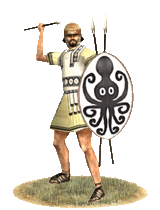 The Peltastai is a type of elite skirmisher that sacrifices heavy arms and armor for mobility and range. They are armored in linen and carry a medium sized ovular shield. Originally, they carried a crescent shaped 'pelta' shield, originated in Thrake and gave the peltastai their name, but this was phased out in the fourth century. Their armaments consist of several javelins and a sword. This panoply makes them light and mobile, but still able to engage in melee after their javelins have been thrown. They are a versatile unit but one must remember that their primary arms are javelins, and they are not equipped to stand toe to toe with heavier infantry. Their role is one of speed, harassment, and critical flanking maneuvers. The Peltastai is a type of elite skirmisher that sacrifices heavy arms and armor for mobility and range. They are armored in linen and carry a medium sized ovular shield. Originally, they carried a crescent shaped 'pelta' shield, originated in Thrake and gave the peltastai their name, but this was phased out in the fourth century. Their armaments consist of several javelins and a sword. This panoply makes them light and mobile, but still able to engage in melee after their javelins have been thrown. They are a versatile unit but one must remember that their primary arms are javelins, and they are not equipped to stand toe to toe with heavier infantry. Their role is one of speed, harassment, and critical flanking maneuvers.
Historically, the peltastai were often hoplitai or pezhetairoi equipped to fight in the manner of a skirmisher. This meant that they were adept melee combatants as well as being deadly with their javelins. Peltastai were used to great effect on ancient battlefields but by 270 BC the thureophoros was becoming the dominant melee skirmisher and the peltastai were carrying more javelins and were used in a manner that was consistent with this. This was simply a matter of specialization, and it did not mean that peltastai would be any less effective if deployed correctly. Their light armament makes them extremely fast, but tends to be to their detriment in melee combat. They were mostly used in the role of supporting missile troops who charged in at the last moment, after they had spent all their javelins. The great Athenian general Iphikrates is credited with the invention of the peltast as a distinct unit, and it is he that first employed them in this manner to great effect against the heavier armored and better trained hoplitai of Sparte.
Uazali (Karian Warband)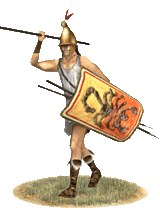 The Uazali are warbands of soldiers from the peoples of the southern coast of Mikra Asia: the Karians, Lykians, Pamphylians, and Pisidians. These warlike peoples have long traditions of military service abroad, and of nearly constant local warfare between the small cities and towns separated by the towering heights of the western Taurus. These Uazali are skilled mountain fighters. Their name comes from the Lykian tongue, and means "Warriors," and is similar also to the words used by the other peoples along the southern coast of Mikra Asia, all of whose languages derived primarily from the Hittite tongue. The Uazali carry a solid rectangular shield slung over the shoulder to ease the burden on the arms, emblazoned with signs of their peoples, and wear a solid Phrygian helm, a common form of protection among those in Asia who could afford such things. For weapons, they carry several javelins and a lengthened xiphos sword, which became a popular weapon in Mikra Asia, both as a result of the Iphikratid reforms, and out of experience fighting the Galatai, with their longswords. Their shields and helmets provide them a great deal of protection compared to most other skirmishing units, and their ferocity in melee surpasses most of their peers. The Uazali are warbands of soldiers from the peoples of the southern coast of Mikra Asia: the Karians, Lykians, Pamphylians, and Pisidians. These warlike peoples have long traditions of military service abroad, and of nearly constant local warfare between the small cities and towns separated by the towering heights of the western Taurus. These Uazali are skilled mountain fighters. Their name comes from the Lykian tongue, and means "Warriors," and is similar also to the words used by the other peoples along the southern coast of Mikra Asia, all of whose languages derived primarily from the Hittite tongue. The Uazali carry a solid rectangular shield slung over the shoulder to ease the burden on the arms, emblazoned with signs of their peoples, and wear a solid Phrygian helm, a common form of protection among those in Asia who could afford such things. For weapons, they carry several javelins and a lengthened xiphos sword, which became a popular weapon in Mikra Asia, both as a result of the Iphikratid reforms, and out of experience fighting the Galatai, with their longswords. Their shields and helmets provide them a great deal of protection compared to most other skirmishing units, and their ferocity in melee surpasses most of their peers.
Historically, many young men from Karia, Lykia, Pamphylia and Pisidia went overseas to serve as mercenaries, or were recruited in their native lands as militias and katoikoi for the successors. Many of the most Hellenized inhabitants joined the ranks of thureophoroi and other medium infantry units in other lands. Many others, however, stayed closer to their native infantry traditions, and served abroad as warrior bands, or as locally-recruited troops in their own lands. They were used to great effect in irregular mountain combat, but also distinguished themselves in assaults, and if they end up in the battle line in major pitched battle, a good commander will maximize their skirmishing and melee abilities by using them in a flanking, ambushing, or screening role if at all possible.
Thureophoroi (Hellenic Spearmen)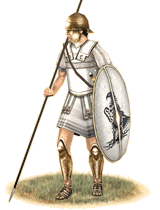 Thureophoroi were a new class of Hellenic infantry that was designed to both augment the phalanx and provide a type of soldier in between the phalangite and the peltastai that was able to both skirmish and fight in melee effectively. These men provide an extremely mobile force that can hit hard with their heavy javelins then rush in to flank pike units. They are well armed and armored for the task, having stout bronze helms, linen armor, an almond shaped thureos shield, heavy javelins, and a stout spear. They are highly versatile infantry, akin in spirit to the legionaries of Rome. They are a highly effective force of heavy infantry that is in the forefront of Hellenic military know-how. Thureophoroi were a new class of Hellenic infantry that was designed to both augment the phalanx and provide a type of soldier in between the phalangite and the peltastai that was able to both skirmish and fight in melee effectively. These men provide an extremely mobile force that can hit hard with their heavy javelins then rush in to flank pike units. They are well armed and armored for the task, having stout bronze helms, linen armor, an almond shaped thureos shield, heavy javelins, and a stout spear. They are highly versatile infantry, akin in spirit to the legionaries of Rome. They are a highly effective force of heavy infantry that is in the forefront of Hellenic military know-how.
Historically, Thureophoroi were used as harassing and flanking troops by the successor states. Though they were often described by Latin writers as copies of the legion, it is debatable whether they were developed with knowledge of warfare in Italy or not. Most Thureophoroi were Pezhetairoi, middle class property owners with voting rights, and as such, they were well able to devote time to training and practice and were highly disciplined and courageous troops. Despite their obvious advantages, or perhaps because of them, there was a lot of confusion as to how to utilize these new soldiers. As were deadly in the extreme to the less mobile phalanx units they forced a, much resisted, revaluation of Hellenic warfare. Perhaps for this reason the Diodachoi tended to used them conservatively, except for the Seleukidai, who took to these new soldiers quite well. The city-states of Hellas used them even more frequently against the armies of Makedonia, and were often able to hold the more powerful kingdom at bay. Still, their uses were limited in scope and not as widespread as their versatile and deadly role would have indicated. This is the fault of period commanders, however, and a more astute or innovative commander might have realized their potential in conjunction with the more static phalanx.
Thorakitai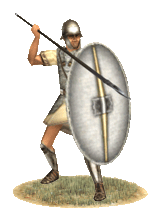 The Thorakitai represent the second evolution of the concept of the Theurophoroi, and show definite influence by the Romaioi in their implementation. They are armored in mail and carry heavy javelins instead of the lighter javelins carried by the Thureophoroi. They are more expensive and less mobile than their more lightly armored companions, but make excellent shock troops for any Hellenic army. They are best utilized on the flanks of the phalanx to either flank the enemy while the phalanx pins them, or prevent enemy flankers from attacking the phalanx's vulnerable flanks. They are best used in combination with the lighter Thureophoroi, who can support them with extra javelins and more importantly, speed, to make sure they are not surrounded. The Thorakitai represent the second evolution of the concept of the Theurophoroi, and show definite influence by the Romaioi in their implementation. They are armored in mail and carry heavy javelins instead of the lighter javelins carried by the Thureophoroi. They are more expensive and less mobile than their more lightly armored companions, but make excellent shock troops for any Hellenic army. They are best utilized on the flanks of the phalanx to either flank the enemy while the phalanx pins them, or prevent enemy flankers from attacking the phalanx's vulnerable flanks. They are best used in combination with the lighter Thureophoroi, who can support them with extra javelins and more importantly, speed, to make sure they are not surrounded.
Historically, the Thorakitai were used much like the Thureophoroi, but more rarely and later on. They were expensive soldiers, and one had to be fairly wealthy to equip one's self as a Thorakites. They were only used in any real numbers by the Seleukidai and the city-states of Hellas. They were never used to their full potential until the Romaioi raised legions in Hellas, and the type of fighting practiced by the Romaioi Legions and Thorakitai became the norm rather than the exception.
Klerouchoi Phalangitai (Hellenic Medium Phalanx)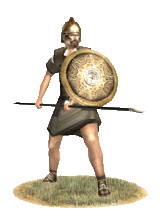 The Klerouchoi Phalangitai form the backbone of the Successor armies of Aigyptos and Asia, along with the less numerous Pezhetairoi. These men are given a plot of land or kleros, maybe some slaves and a tax reduction and in return they serve in the phalanx when called upon to war by their Basileus. They are citizens just as the Pezhetairoi, but they are citizens with-strings-attached, as they are required to fight when called upon or otherwise their livelihood might be taken away from them. The Klerouchoi Phalangitai form the backbone of the Successor armies of Aigyptos and Asia, along with the less numerous Pezhetairoi. These men are given a plot of land or kleros, maybe some slaves and a tax reduction and in return they serve in the phalanx when called upon to war by their Basileus. They are citizens just as the Pezhetairoi, but they are citizens with-strings-attached, as they are required to fight when called upon or otherwise their livelihood might be taken away from them.
Even though the phalanx is a Hellenic soldier formation, some Thraikes, Keltoi, Ioudaioi and other subjects were also given Klerouchos status to increase the number of Phalangitai available, but the main bulk of the Klerouchoi Phalangitai are still Hellenes. Each soldier is armed with the sarissa and wears a linen or leather cuirass, a Thracian helm, and a Makedonian pelte provided by the Basileus. In battle they are best deployed in a defensive posture, or in a slow but steady advance towards the enemy, grinding down their opponents' numbers through attrition, or to pin enemy formations so they can be flanked by other units.
The wars which followed the breakup of Megas Alexandros' empire drained the Makedonian armies of many of their Makedones. For the western Diadochoi, levies from populations could take place directly, but the eastern Diadochoi depended on their dwindling standing armies or on new mercenary recruits. They needed a renewable source of Hellenic recruits if they were to keep power and retain their military strength. As the pike-phalanx was the backbone of their armies, they needed Hellenes to fill its ranks. While mercenaries could temporarily fulfill such a need, their loyalty was never assured, while their demands for pay always were.
The answer was the establishment of Hellenic military-settlements throughout the Successor states, where a soldier was given a plot of land and reduced taxes. Sometimes they were given some slaves too, to work their alloted land, freeing up more time for the Klerouchos soldier to be on campaign. Arming the native population (Aigyptioi in the Ptolemaic kingdom, Syriakoi and Babylonioi in the Seleukid Empire), was less appealing, as that would have laid the Makedonian dynasties open for native revolts in their respective heartlands. In Aigyptos most Klerouchoi were settled in the Fayum depression, but many others were settled further to the south, though in smaller numbers.
Klerouchoi were also settled by the Ptolemaioi in settlements in Asia, Kypros, and Koile Syria, but nearly all Hellenic, Klerouchoi Phalangitai were settled in Aigyptos, and primarily in the Arsinoite and Herakleopolite nomes, in or near the Fayum. In the Arche Seleukeia these settlements, called Katoikiai, were established in western Asia around Sardis, throughout Syria and Mesopotamia, and as far away as Baktria and Paropamisadai. The Klerouchoi population in Aigyptos eventually deteriorated, and lost much of its martial character after the arrival of the Romans, while the Katoikiai in Seleukid regions, especially those in western Asia, passed into the hands of the Pergamenes first, then Pontos, and finally the Romaioi.
Pezhetairoi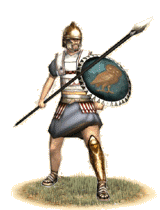 The Pezhetairoi are heart of the military machine of all the Diodachoi kindgoms. They are well disciplined and highly motivated pikemen that are armed and armored to the teeth. They are armored in a linen cuirass, a Thraikian cap, a bronze greave on the left leg, stout boots, good bracers, and reinforced shoulder pads made from hardened linen (due to their experience with the deadly curved swords of Thrace). They have Illyrian style round shields attached to their bodies by leather straps that help support the weight of the shield and keep their hand free to grasp the long and unwieldy sarissa. They are defensive infantry par excellence and are the anvil of the two part Makedonian system of warfare, the heavy cavalry being the hammer. They should be used to anchor enemy soldiers while the Theurophoroi harass the flanks and the heavy cavalry smashes into the flanks and rear. The Pezhetairoi are heart of the military machine of all the Diodachoi kindgoms. They are well disciplined and highly motivated pikemen that are armed and armored to the teeth. They are armored in a linen cuirass, a Thraikian cap, a bronze greave on the left leg, stout boots, good bracers, and reinforced shoulder pads made from hardened linen (due to their experience with the deadly curved swords of Thrace). They have Illyrian style round shields attached to their bodies by leather straps that help support the weight of the shield and keep their hand free to grasp the long and unwieldy sarissa. They are defensive infantry par excellence and are the anvil of the two part Makedonian system of warfare, the heavy cavalry being the hammer. They should be used to anchor enemy soldiers while the Theurophoroi harass the flanks and the heavy cavalry smashes into the flanks and rear.
Historically, the Pezhetairoi are the classic Alexandrian phalanx. They were used to great effect against the Persai, Medoi, Baktrioi, Indoi, Phoinikoi, and many, many others. They are an effective force and have not changed much over the centuries. The Romaioi were able to defeat them as easily as they did for two main reasons. One, the Romaioi army was at a high state of readiness and tactical prowess after defeating the Karchedoi. Two, the heavy cavalry arm of the Diodochoi armies had degenerated to the point where they were no longer able to field significant numbers to fulfill their part of the hammer and anvil tactic of Alexandros. There were also many lesser reasons, numbering among them the misuse of the Thureophoroi, the under use of Peltastai, and the lax state of warfare that the Diodachoi states were used to. In any case, the phalanx was not as anachronistic or inflexible as widely believed; it was simply misused and under-supported. In the thirteenth century and onwards, pikemen in similar formations were able to work wonders with more capable generals and a better cavalry arm. Do not under appreciate pikemen, for they are still a war winning force.
Machimoi Hippeis (Machimoi Light Cavalry)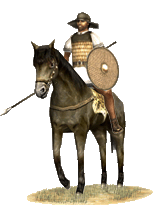 Machimoi cavalry are the best fighting force that is conscripted in times of need by the Ptolemaioi. They are formed from the native nobility, many of whom have intermarried with their Makedonian overlords and are thus more loyal than the other natives. Still, they are often present in native revolts, due to the fact can often taking leading roles in any uprising. They fight in a manner consistent with other medium cavalry, but are more lightly armored and consequently faster. They are armed with both spears and axes and are able to deliver a powerful charge and fight in melee if well supported. Machimoi cavalry are the best fighting force that is conscripted in times of need by the Ptolemaioi. They are formed from the native nobility, many of whom have intermarried with their Makedonian overlords and are thus more loyal than the other natives. Still, they are often present in native revolts, due to the fact can often taking leading roles in any uprising. They fight in a manner consistent with other medium cavalry, but are more lightly armored and consequently faster. They are armed with both spears and axes and are able to deliver a powerful charge and fight in melee if well supported.
Historically, the lower native nobility of Aigyptos formed these cavalry regiments for the Ptolemaioi. They were used to good effect at Raphia and other battles, but often proved to be a thorn in the side of Ptolemaic kings. They made excellent raiders and good 'jack of all trades' cavalry, which made them just as useful under the command of a native who was trying to restore Aigyptos to Aigyptian rulers…
Lonchophoroi Hippeis (Hellenic Medium Cavalry)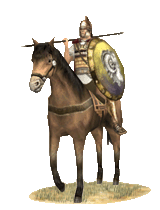 Hail Stratege! Fine noblemen forming a sturdy body of cavalry whose purpose is to crash into your foe and have the staying power to breach his line are here, arrayed before you. Armed with stout single handed lances and the mighty aspis of our ancestors, they can unleash a terrible charge. Once they have inflicted gruesome casualties on our enemies, they will switch to their melee weapon and begin a close-in slaughter. While men from Epeiros or Makedonia proper would have the sturdy Kopis, men further east may prefer the stout bladed war axe like that used by Alexander at the Granicus. They are armored with scale reinforced linen, greaves, and masked Phrygrian helmets that betray naught but the angry face of Zeus Pater or wrathful Poseidon. They are best used as a general purpose heavy cavalry. However, if facing the sturdier men from the east, or, Gods forbid, the elite Hetairoi or massive Kataphraktoi of the Seleukides and Baktrioi, they may not have the staying power that they would against other heavy cavalry. Use them well, and they will give your enemies naught but the death they so richly deserve! Hail Stratege! Fine noblemen forming a sturdy body of cavalry whose purpose is to crash into your foe and have the staying power to breach his line are here, arrayed before you. Armed with stout single handed lances and the mighty aspis of our ancestors, they can unleash a terrible charge. Once they have inflicted gruesome casualties on our enemies, they will switch to their melee weapon and begin a close-in slaughter. While men from Epeiros or Makedonia proper would have the sturdy Kopis, men further east may prefer the stout bladed war axe like that used by Alexander at the Granicus. They are armored with scale reinforced linen, greaves, and masked Phrygrian helmets that betray naught but the angry face of Zeus Pater or wrathful Poseidon. They are best used as a general purpose heavy cavalry. However, if facing the sturdier men from the east, or, Gods forbid, the elite Hetairoi or massive Kataphraktoi of the Seleukides and Baktrioi, they may not have the staying power that they would against other heavy cavalry. Use them well, and they will give your enemies naught but the death they so richly deserve!
Historically, the lancers of later Hellenistic armies were divided into several types. Some cavalry performed shock roles as a secondary function, with the charge itself being their goal, and thus it became necessary to develop a specific force of cavalry who could charge in suppport but lend staying power to their comrades. This sort of cavalry was used to great effect by the forces of Syrakousai and Taras in the west, Epeiros, Pergamon and Makedonia in the heartland of the Greek and Makedonian peoples, and the even the great Hellenistic kingdoms of Aigyptos, Syria, and Baktria. They appear on both sides at the battle of Magnesia, where they and the Pergamene Hetairoi checked the advance of more heavily armored Seleukid cavalry, allowing the Romans to roll up the line of Seleukid infantry. Still, they have some weaknesses, and should not be expected to defeat elite troops in prolonged battle.
Prodromoi (Successor Medium Cavalry)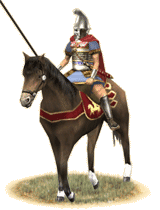 Prodromoi are the lightest of the Diadochoi melee cavalry and can be counted upon as superb flanking, raiding, and screening cavalry. They are well trained for light cavalry, but are still lightly armed and armored. They are not meant to be used as shock cavalry and will not roll up an enemy battle line in a thunderous charge, but instead make viable flanking cavalry which can quickly provide support where it is needed and be used to counter light missile troops of both the foot and mounted varieties. Their spears, shields, and linen armor give them some staying power, but they should not be used to in protracted melee for any great amount of time. Prodromoi are the lightest of the Diadochoi melee cavalry and can be counted upon as superb flanking, raiding, and screening cavalry. They are well trained for light cavalry, but are still lightly armed and armored. They are not meant to be used as shock cavalry and will not roll up an enemy battle line in a thunderous charge, but instead make viable flanking cavalry which can quickly provide support where it is needed and be used to counter light missile troops of both the foot and mounted varieties. Their spears, shields, and linen armor give them some staying power, but they should not be used to in protracted melee for any great amount of time.
Historically, the Seleukidai and Makedones used the smaller and weaker members of the nobility to form a quick and powerful light cavalry force that could decide an engagement on its own. Since these men are nobles, they have good staying power, as was evidenced by their widespread use in many battles. They are quick, and can be used to chase down missile cavalry when there is a need, due to the fact that they ride fast Thessalian horses and are relatively slight statured men. The Seleukidai use them as an effective counter to the Parthoi horse archers, much like the Hungarians of a later era did against the Turks.
Elephantes Hulaioi Liboukoi (African Forest Elephants)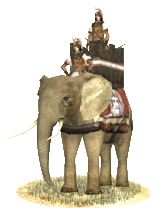 Imported from the regions far south of Aigyptos or from the mountain forests of northwestern Africa, forest elephants are an exceptionally valuable resource in combat, used mainly by the Ptolemaioi and Qarthadastim. Towering over most other creatures, they can easily scare men and horses alike, with both their size and smell, though elaborate bells and trappings often add to their intimidation. Such corps are directed by their own mahouts riding behind their heads, often a native of their own country who has spent at least two years training his beast from capture. The mahout is armored to better protect against the obvious assault that generally comes against him, launched to bypass the thick natural armor of his mount. Imported from the regions far south of Aigyptos or from the mountain forests of northwestern Africa, forest elephants are an exceptionally valuable resource in combat, used mainly by the Ptolemaioi and Qarthadastim. Towering over most other creatures, they can easily scare men and horses alike, with both their size and smell, though elaborate bells and trappings often add to their intimidation. Such corps are directed by their own mahouts riding behind their heads, often a native of their own country who has spent at least two years training his beast from capture. The mahout is armored to better protect against the obvious assault that generally comes against him, launched to bypass the thick natural armor of his mount.
Elephants are best used as cavalry screens for your army, where their presence can scare away enemy cavalry. They can also be used to ram through an enemy battle line, though they are less useful when faced with loose order or phalanx infantry. Pyrrhos of Epeiros even innovated a tactic of flank screens when he fought the Romans at Heraklea. Beyond their obvious use against enemy infantry or cavalry, they can also be used in siege combat; battering down gates, though they're highly vulnerable to better prepared installations. Their greatest vulnerability is against skirmishers, slingers and archers, who can pepper them with missiles - eventually toppling them by virtue of their cumulative impact. To counter the effect of enemy skirmishers, it is often wise to array your own in opposition, or to maintain constant attacks upon each individual group.
Historically, the use of elephants in war was largely contained to India, but after the battle of Hydaspes that changed. Though Alexandros never cared over much for the animals, his successors were very much in favor of their use, organizing their own elephants into a distinct corps under their own "elephantarchos". The forest elephant was used in battle after the Ptolemaioi dynasty established itself in Egypt. Being cut off from India by their Seleukid rivals, the Ptolemaioi needed another source of elephants and sent expeditions to the Horn of Africa to gather Forest Elephants and later they established “elephant stations” to make sure the Ptolemaic armies were well supplied.
Qarthadastim also used forest elephants in war and they seem to have begun using them around 300 BC. The forest elephants were captured in the Tunisian mountain forests, but the Carthaginians also imported elephants from the Seleukides and Ptolemaioi, which might indicate the native herds were not enough to supply the Carthaginian elephant corps.
The Forest Elephant was smaller in size and strength compared to the Indian elephant. The battle of Raphia is often used as an example of the Indian elephant’s superiority, as Antiochus III elephants routed Ptolemaios IV elephants, yet it’s important to remember that Ptolemaios IV elephants were outnumbered at that battle.
A side effect of the Ptolemaic use of elephants caused the kingdom of Meroe to also start to tame and use elephants during the Hellenistic period, a practice they eventually taught to the Ethiopians as well. The forest elephants could be found in north-western & eastern Africa, but after the Romans conquered north-western Africa they hunted the forest elephant there to extinction due to their love for using them in circus and the arenas.
Despite their great usefulness when properly employed, it was not unusual for elephants to cause defeat for those who employed them. If an enemy was clever enough to devise their own means to combat elephants, as was the case at the battle of Gaza when Ptolemaios planted an ‘iron spiked minefield’ to ward off elephants, or when Caesar properly utilized slingers and Scipio gaps between his infantry cohorts to channel the elephants, they could be defeated and even turned against their masters. Even pigs were used on occasion, released among elephants who were often scared of their comparatively small, darting forms. However, despite the many different weapons and stratagems being devised to fight them and the huge expenses required to maintain them, the elephant was still considered a valuable asset, maintained widely. The Arche Seleukeia even developed a corps of "elephant guards", whose task was simply to defend the beasts in combat.
Galatikoi Kleruchoi (Galatian Heavy Infantry)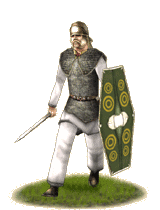 Galatians were used as mercenaries by all the Diadochoi, but none used them as extensivly as did the Ptolemaioi. The Ptolemaioi imported Galatai and other Keltoi and gave them land and peasants in the Fayuum depression and other areas in return for their services as reliable heavy infantry. Their equipment reflects their position and wealth within the Aigyptian forces. They are armored in good quality mail and wear light linen shirts and trousers. They were given bronze Attic-style Hellene helmets in place of their old equipment, and took to these rather well. They have excellent morale and discipline, since their whole purpose in life (other than turning a profit on their estates) is the service of the Ptolemaios kingdom in war. They should be used as a heavy infantry force in keeping with the knowledge that they outmatch most other eastern heavy infantry. They are impetuous but well trained and capable of keeping good order, their only serious weakness is cavalry. Galatians were used as mercenaries by all the Diadochoi, but none used them as extensivly as did the Ptolemaioi. The Ptolemaioi imported Galatai and other Keltoi and gave them land and peasants in the Fayuum depression and other areas in return for their services as reliable heavy infantry. Their equipment reflects their position and wealth within the Aigyptian forces. They are armored in good quality mail and wear light linen shirts and trousers. They were given bronze Attic-style Hellene helmets in place of their old equipment, and took to these rather well. They have excellent morale and discipline, since their whole purpose in life (other than turning a profit on their estates) is the service of the Ptolemaios kingdom in war. They should be used as a heavy infantry force in keeping with the knowledge that they outmatch most other eastern heavy infantry. They are impetuous but well trained and capable of keeping good order, their only serious weakness is cavalry.
Historically, Galatai were imported in such numbers as to have changed the ethnic makeup of some parts of the country. They often intermarried with the Hellenes and to this day the area around the Fayuum depression in Aigyptos is populated by fair skinned people with light eye colors. The Galatians were fanatically loyal to the Ptolemaioi, being used as a counterweight to the dangerous native troops, which they slaughtered wholesale during two rebellions. After the Roman conquest, these men joined the legions raised in Aigyptos, and spread themselves all over the near east. Theirs is a truly fascinating story that is not often told.
Klerouchikon Agema (Ptolemaic Elite Phalanx)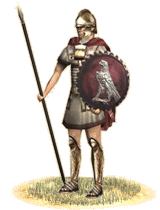 The most numerous of the Kleruchoi were the pikemen, who were often of very high quality. They carry standard equipment for pikemen, much the same as the Pezhetairoi, but are often of higher quality. The Kleruchoi are able, due to their status as lords of small estates, to devote a considerable amount of time to military training. They are best used like their Argyraspidai counterparts, to hold the most crucial portion of a line. They are great phalanx infantry, well able to hold against most opponents. If they have a weakness, it is the classic weakness of pikemen: flanking attacks. The most numerous of the Kleruchoi were the pikemen, who were often of very high quality. They carry standard equipment for pikemen, much the same as the Pezhetairoi, but are often of higher quality. The Kleruchoi are able, due to their status as lords of small estates, to devote a considerable amount of time to military training. They are best used like their Argyraspidai counterparts, to hold the most crucial portion of a line. They are great phalanx infantry, well able to hold against most opponents. If they have a weakness, it is the classic weakness of pikemen: flanking attacks.
Historically, the Kleruchoi Agema formed the nucleus, together with the Galatai, of any Ptolemaic army. Since they had peasants to work their estates, unlike the Pezhetairoi, they could assemble at any time during they year and not have to worry about the management of their estate (due to compensations from the rich Ptolemaic government). They were almost always held in somewhat of a reserve, because the Ptolemaic kings did not want them to be badly mauled in any battle. This was due to the ever-present danger of native revolts within Aigyptos itself. They were dissolved during the Roman occupation, but many joined new legions being raised in Aigyptos.
Agema Klerouchikon Hippeon (Ptolemaic Heavy Cavalry)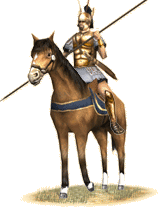 The Fayuum and other places made excellent spots for a heavy cavalry reserve to be raised. With a system of land grants and promises, the Ptolemies were able to lure many Hellenes and Makedonians to settle in Aigyptos and produce a reliable heavy cavalry. They are armed with a xyston, a kopis, and are clad in a light but sturdy bronze curiass. They can be counted upon to give a good account of themselves in battle, due to the fact that they are well trained, almost feudalistic, cavalry. The Fayuum and other places made excellent spots for a heavy cavalry reserve to be raised. With a system of land grants and promises, the Ptolemies were able to lure many Hellenes and Makedonians to settle in Aigyptos and produce a reliable heavy cavalry. They are armed with a xyston, a kopis, and are clad in a light but sturdy bronze curiass. They can be counted upon to give a good account of themselves in battle, due to the fact that they are well trained, almost feudalistic, cavalry.
Historically, the Ptolemaic heavy cavalry was very good, well able to deal with the Seleukidai and other threats. They were able to check the more numerous Seleukid cavalry at Raphia, making sure their vulnerable phalanx was not outflanked. They were in existence up until the end of the Ptolemaic kingdom and many were hired by the Romaioi to provide a heavy cavalry capable of fighting in the east after the absorption of Aigyptos into the Roman Empire.
Basilikon Agema (Royal Guards)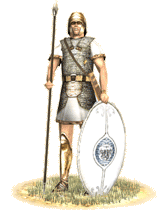 The Ptolemaioi had a problem with their elite infantry from the start. Namely, they didn't have any, since the Seleukidoi and Makedonians took what remained of Alexandros' Hypaspistai. Therefore, they had to build a unit of royal heavy infantry to compete with their rivals. Many things were tried, but ultimately the result was the Basilikon Agema, the Royal Guard. They are armed with hoplites spears and thureos shields and armored in mail, making them more mobile but less well armored than other heavy infantry. They also carry a short sword that was used rather like the Romaioi used theirs. This led to the misidentification of these troops by Latin authors as a sort of imitation legion. The Basilikon Agema is full of good troops, mostly Hellenes and Makedonians with a few Galatai and Kretai. They are an elite infantry, well able to fight in a phalanx and to break the formation and fight with their blades. They are extremely versatile and can be used to good effect by a capable commander. The Ptolemaioi had a problem with their elite infantry from the start. Namely, they didn't have any, since the Seleukidoi and Makedonians took what remained of Alexandros' Hypaspistai. Therefore, they had to build a unit of royal heavy infantry to compete with their rivals. Many things were tried, but ultimately the result was the Basilikon Agema, the Royal Guard. They are armed with hoplites spears and thureos shields and armored in mail, making them more mobile but less well armored than other heavy infantry. They also carry a short sword that was used rather like the Romaioi used theirs. This led to the misidentification of these troops by Latin authors as a sort of imitation legion. The Basilikon Agema is full of good troops, mostly Hellenes and Makedonians with a few Galatai and Kretai. They are an elite infantry, well able to fight in a phalanx and to break the formation and fight with their blades. They are extremely versatile and can be used to good effect by a capable commander.
Historically, the Basilikon Agema were the elite guard of the Ptolemaic king. They went everywhere with their king, and were instrumental in putting down several native revolts along with the Galatai. They outfought the natives with creative tactics that worked well against other successor pikemen as well. Most of the unit was not present at Raphia, but was used to good effect against the Seleukidai on other occasions.
Hetairoi (Companion Cavalry)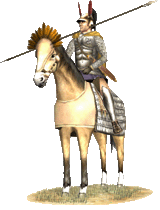 The Hetairoi, or Companions, were the elite noble heavy cavalry of Makedon and the Diadochoi. They are an elite heavy cavalry that is second to none and arguably the best cavalry of the period. They fight with a degree of élan, discipline, and simple ferociousness that is matched only by the horsemen of Iberia, Karchedon, and the best heavy cavalry of the eastern nomadic peoples. They are armored from head to toe in iron plate (some still had bronze, but this was falling out of favor rapidly by 250 BC), reinforced with mail at key points. Their horses are barded with felt barding and often have bronze plates to protect their heads. Their helmets, with the two plumes, mark them on a battlefield. They are best used as heavy shock cavalry, able to decide many battles with a single charge. They are the second part of the hammer and anvil of Alexandrian battle tactics. They are armed with a xyston and a kopis, and are true masters of both weapons. If these men have any weakness, it is the front of a line of spearmen. Horses, not matter how well trained, simply do not want to charge into certain death. Nevertheless, these superb cavalry men are easily able to devastate even the toughest of foes with a well timed charge into their flanks or rear. The Hetairoi, or Companions, were the elite noble heavy cavalry of Makedon and the Diadochoi. They are an elite heavy cavalry that is second to none and arguably the best cavalry of the period. They fight with a degree of élan, discipline, and simple ferociousness that is matched only by the horsemen of Iberia, Karchedon, and the best heavy cavalry of the eastern nomadic peoples. They are armored from head to toe in iron plate (some still had bronze, but this was falling out of favor rapidly by 250 BC), reinforced with mail at key points. Their horses are barded with felt barding and often have bronze plates to protect their heads. Their helmets, with the two plumes, mark them on a battlefield. They are best used as heavy shock cavalry, able to decide many battles with a single charge. They are the second part of the hammer and anvil of Alexandrian battle tactics. They are armed with a xyston and a kopis, and are true masters of both weapons. If these men have any weakness, it is the front of a line of spearmen. Horses, not matter how well trained, simply do not want to charge into certain death. Nevertheless, these superb cavalry men are easily able to devastate even the toughest of foes with a well timed charge into their flanks or rear.
Historically, the Hetairoi were first created by Philippos, following the lead of the cavalrymen of Thessalia, to the south. Philippos went one better, armoring them to the teeth and giving them the xyston, a twelve foot long lance tipped with a large steel head. They were armored head to toe in bronze plate, with helms, cuirass, bracers and greaves. Alexandros often replaced this armor with lighter linen when they were traveling, but was quick to replace the bronze in any hard fought engagement. Alexandros added little to their equipment but trained them to ride their horses in such a way that each man was an expert horsemen as well as a shock cavalryman. The Diadochoi kept this mold, but added mail reinforcement to the bronze armor at the joints before replacing it with iron and added felt and lamellar barding to the horses after encountering enemy cavalry that used such equipment with a high degree of success. During the third century their usage declined with the Diadochoi's ability to pay for such heavily armored men. They degenerated to such a point where only a handful were present at major battles, and were far from the war winning force that they had been earlier. Perhaps with a bit of luck and more funding, a commander could use them in their true glory once more…
Toxotai Kretikoi (Cretan Archers)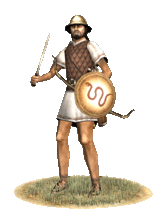 The island of Crete is renown for it's archers, and Cretans renown for their reputation as liars and brigands. These men hire themselves out as mercenaries for almost any Mediterranean power who can afford them, as their skills are often unmatched by other archers. Apart from their bow, they also have short swords and they wear hardened linen armor and carry a small shield. Not only are the Cretans good archers, but they can also fare well in melee, although against similarily equipped opponents. The island of Crete is renown for it's archers, and Cretans renown for their reputation as liars and brigands. These men hire themselves out as mercenaries for almost any Mediterranean power who can afford them, as their skills are often unmatched by other archers. Apart from their bow, they also have short swords and they wear hardened linen armor and carry a small shield. Not only are the Cretans good archers, but they can also fare well in melee, although against similarily equipped opponents.
Historically, Toxotai Kretikoi served in most Hellenic armies and other Mediterranean armies from early history, from Carthage in the west to the Seleukids in the east. One of their most famous exploits was in Xenophon's "Ten Thousand", where they gave a good account of themselves against the Persians. Crete during this time was rife with civil wars, and it was often those Cretans on the losing side or who get fed up with the unstable situation, who migrated overseas and hired themselves out as mercenary bowmen. The Diadochoi tried to gain control of the island, but were unsuccesful in their attempts. The constant civil wars attracted outlaws and other unwantables to Crete, that during the Hellenistic period bad behaviour was called "Cretan Way" and during the 1st century BC, the Cilician pirates established themselves on Crete and many Cretans joined them in piracy, which drew the ire of Rome. The first Roman expedition in 74 BC was soundly defeated, but the second expedition in 68 BC managed with great brutality to subjugate the island, which was afterwards made into a military colony, who for centuries to come supplied the Roman army with auxiliary archers, and their renown continued well into the Middle Ages. There is even distinct mention of Cretan archers defending Constantinople in 1453 AD!!
Hoplitai Troglodutikes (Red Sea Hoplites)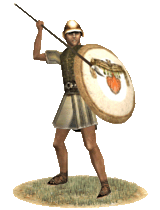 Hoplitai Troglodutikes (Erythraian Sea Hoplites) are mostly Hellenic colonists who were drawn to the Erythraian Sea coast. After initial exploration Ptolemaioi founded colonies in there to hunt elephants and trade with the natives and as far as India. Local garisson forces took part in those hunts and many of the veterans remained on those colonies after retiring. As in each Hellenic polis, a local force of hoplites would be summoned at time of need. Having completed the rigorous "ephebike askesis" they would be ready to fight against their enemies and as such the rigorous demands for citizenship have been lowered to whomever is available. The enemies aren't hoplites or Phallangitai. They are the skirmishers and spearmen of the Troglodytai, the fierce archers of Meroe and Inner Aithiopia, and maybe even the lightly armored but deadly Sabaioi. Hellenic discipline and courage can win the day, but not by underestimation of those enemies. Against those, while retaining the same offensive equipment, (spear and aspis shield), bronze muscle cuirass and linothorax have been dumped in favor of lighter quilted armour. It is easier to wear in the tropics as ancient Aigyptioi had proven. No pteryges, as they add to weight and can raise body temperature. A trusty "machaira" compliments their equipment too. Their helmet is an evolved Boiotian, the ideal helmet for providing some sort of eye protection in the desert and african coast. Their aspis has no bronze coating, relying on elephant skin instead. Natives had been using such an arrangement, for some time. Now Hoplitai Troglodutikes must do the same. Hoplitai Troglodutikes (Erythraian Sea Hoplites) are mostly Hellenic colonists who were drawn to the Erythraian Sea coast. After initial exploration Ptolemaioi founded colonies in there to hunt elephants and trade with the natives and as far as India. Local garisson forces took part in those hunts and many of the veterans remained on those colonies after retiring. As in each Hellenic polis, a local force of hoplites would be summoned at time of need. Having completed the rigorous "ephebike askesis" they would be ready to fight against their enemies and as such the rigorous demands for citizenship have been lowered to whomever is available. The enemies aren't hoplites or Phallangitai. They are the skirmishers and spearmen of the Troglodytai, the fierce archers of Meroe and Inner Aithiopia, and maybe even the lightly armored but deadly Sabaioi. Hellenic discipline and courage can win the day, but not by underestimation of those enemies. Against those, while retaining the same offensive equipment, (spear and aspis shield), bronze muscle cuirass and linothorax have been dumped in favor of lighter quilted armour. It is easier to wear in the tropics as ancient Aigyptioi had proven. No pteryges, as they add to weight and can raise body temperature. A trusty "machaira" compliments their equipment too. Their helmet is an evolved Boiotian, the ideal helmet for providing some sort of eye protection in the desert and african coast. Their aspis has no bronze coating, relying on elephant skin instead. Natives had been using such an arrangement, for some time. Now Hoplitai Troglodutikes must do the same.
Historically Ptolemaioi were very interested in the southern regions of their domain. Akte Troglodutike or the coast of the Troglodutes was perhaps the "wild, unexplored" frontier of the time. The rising elephant hunts as well as the trade with Sabaioi and Indoi, led to the founding of a series of Colonies, with Filotera, "founded by Satyr [a Ptolemaioi general] when he was sent hunting elephants in Troglodytiki" (Strabo,16,4-5) being the first. Soon enough, Arsinoe Troglodytiki, Berenike Troglodytiki, Ptolemais of the Elephantotheron (Elephant hunters) were founded. As frontiermen always do, those people cared more for what someone could do, not the purity of his Hellenic blood. Thus Hellenised Aigyptians and other nationals could be there and perfectly fit in. However rich and promising their situation was, their enemies were at the doors as to a Troglodyte which many of them were, the Colonists were godly rich. The local hoplites fight as ekdromoi mostly, since this is the only way they can effectively deal with the fluid battlefield environment in that area. Colonies in that region existed for many centuries and that was due, in no small part to the ability of their inhabitants to defend them.
|
 |
|
 |






















|